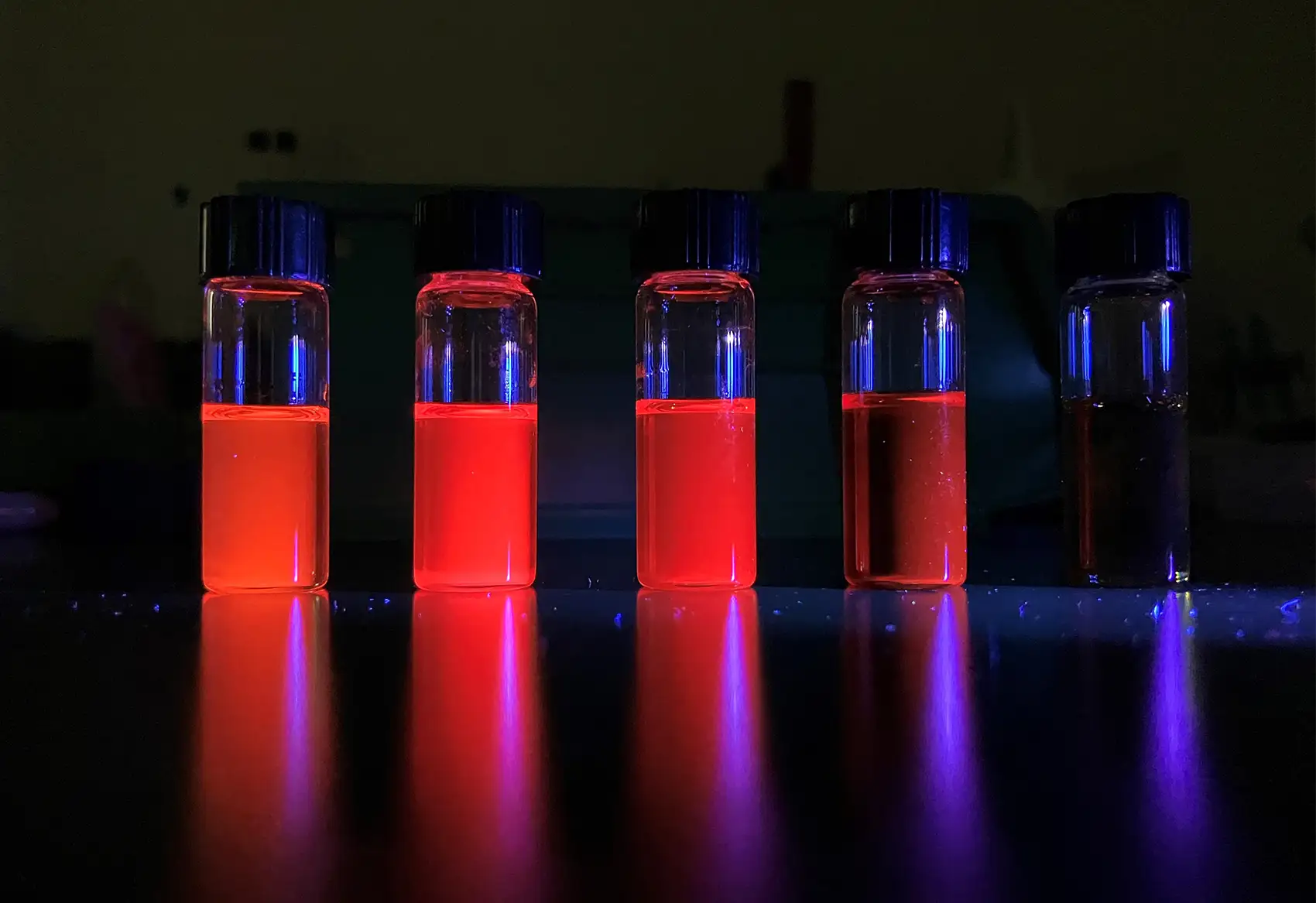Built for Brilliance: Zintl-Phase Quantum Dots Illuminate New Opportunities for Optoelectronics
NREL-Synthesized BaCd₂P₂ Quantum Dots Demonstrate Promising Performance With Earth-Abundant Materials

Just one year after NREL materials science researchers Matthew Hautzinger and Sage Bauers met to exchange notes on underexplored materials in nanotechnology, their synthesis of promising Zintl-phase quantum dots is attracting attention with its bright photoluminescent glow, chemical stability, and Earth-abundant ingredients.
“Recently, scientists have reassessed material compounds that were developed 40–50 years ago but largely forgotten to find new inorganic material candidates that might be useful for modern optoelectronics,” Hautzinger said. “Intermetallic compounds known as Zintl-phase materials, specifically BaCd2P2, captured our attention due to an optimal bandgap, long carrier lifetime, and notable defect tolerance.”
Recognizing that current methods to prepare Zintl-phase materials for optoelectronics are impractical, these NREL scientists were inspired to pursue first-of-its-kind synthesis and characterization of Zintl-phase BaCd2P2 colloidal quantum dots and demonstrate how this compound could integrate with real-world applications.
Quantum dots are the building blocks for many next-generation semiconductors that both absorb light and carry an electric charge. These tiny crystals emit a big glow that could illuminate the next wave of advancements in optoelectronics by improving light-emitting diode lighting and displays, optical fibers for telecommunications, solar panels, bioimaging devices, and optical sensors. The uniquely tiny structure of quantum dots—only a few nanometers—allows BaCd2P2 and adjacent compositions to be tailored for a wide range of applications due to size-tunable optical and electronic properties based on quantum confinement effects associated with quantum dots.
“Stabilizing BaCd2P2 as a quantum dot helps enhance the functionality and answers crucial questions about the intrinsic performance of these materials,” Bauers added. “In just the first synthesis, the photoluminescence of BaCd2P2 glowed impressively bright, despite a relatively unoptimized growth and no specific passivating treatments, which indicates a promising future for this material.”
Seeking Stability at a Smaller Scale
The key to BaCd2P2 synthesis started with the defect tolerance of the compound, as predicted by theoretical calculations and confirmed by preliminary experimental results on powder samples at NREL.
“In classic semiconductor systems, we go to great lengths, such as surface passivation, to keep materials pure,” Hautzinger explained. “Any small impurity could be detrimental to the optoelectronic performance. Because BaCd2P2 has intrinsic properties that prove more tolerant to defects, we hypothesized that the particles would be easier to manipulate into quantum dots.”
That hypothesis was correct. To create the BaCd2P2 quantum dots, the team used a process that involves quickly injecting a phosphorus precursor into a heated ligand-solubilized mixture containing barium and cadmium. By adjusting temperature during growth, it is possible to control the size of the nanoparticles for specific light absorption and color emissions. To structurally characterize the BaCd2P2 quantum dots and confirm they match the crystal structure and composition of the larger, solid version of the material, the team used materials characterization techniques such as selected area electron diffraction, X-ray diffraction, Raman spectroscopy, and X-ray fluorescence.
Visually Striking, Precisely Tuned
The resilience demonstrated by BaCd2P2 offered another unexpected advantage when the resulting colloidal quantum dots emitted a brilliant glow under a black light without the complex chemical treatments typically required to optimize photoluminescence. The calculated photoluminescence quantum yield—a measure of how efficiently a material emits light after energy absorption—of 21% for the BaCd2P2 solution, is an initial result well on the way to industry-standard treated materials.
In short, the BaCd2P2 colloidal quantum dot solution achieved impressive photoluminescent performance right away, marking a leap forward in both simplicity and efficiency. The next challenge, however, was to show how the material could integrate with real-world applications.
To investigate this, the team applied the BaCd2P2 solution to spin-coat thin films similar to those used in optoelectronic devices. They used scanning electron microscopy and time-resolved microwave conductivity to characterize these films, finding a smooth, pinhole-free surface. Demonstrating these films will allow them to expand on this work and incorporate BaCd2P2 into optoelectronic platforms.
“In creating these quantum dots, we have created a framework to simplify the synthesis process without sacrificing tunability or control of the material properties,” Bauers said. “Films created with BaCd2P2 quantum dots could be easier and cheaper to produce than existing technologies while still offering excellent, high-performing photoluminescence.”
A Brighter Future for Optoelectronics
BaCd2P2 quantum dots do not just glow bright; they are also based on abundant constituent materials.
“Unlike competing technologies, which rely on critical minerals, the ingredients used in the synthesis of the BaCd2P2 quantum dots are both Earth-abundant and already domestically produced,” Hautzinger said. “This approach has the potential to ease supply chain constraints by using minerals that are widely available here in the United States.”
Furthermore, the team experimented with partially exchanging the cadmium for zinc within the synthesis process to reduce the toxicity of the material while retaining the impressive photoluminescent properties.
“This is all brand new,” Bauers said. “We are excited to continue poking and prodding these materials to see how subtle changes to their materials chemistry could uncover additional beneficial properties and emerging physics”
Whatever the future holds for BaCd2P2, this fundamental use-inspired research opens the door to a new class of quantum dot materials based on Zintl phases, lighting the way toward new possibilities for optoelectronics.
Learn more about basic energy sciences at NREL and about the U.S. Department of Energy's Office of Science Basic Energy Sciences program. Read “Synthesis and Characterization of Zintl-Phase BaCd2P2 Quantum Dots for Optoelectronic Applications” in ACS Nano.
Last Updated May 28, 2025
